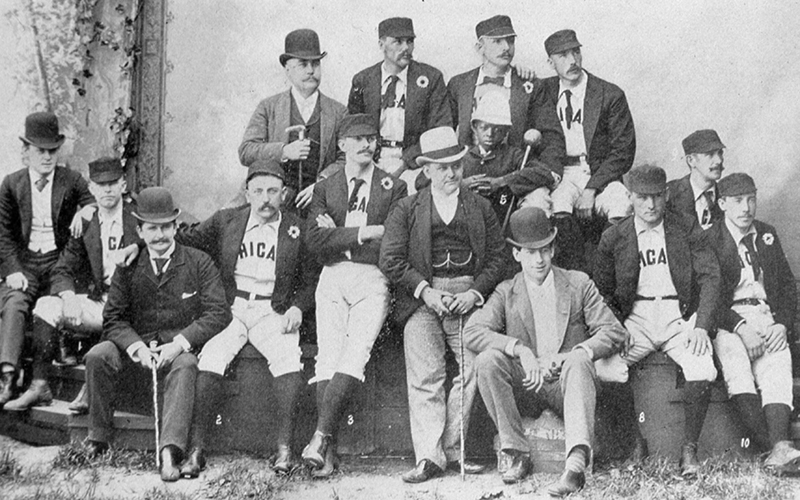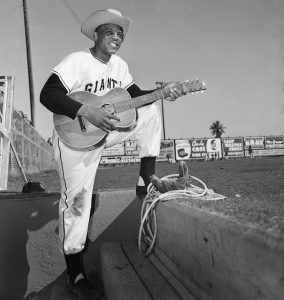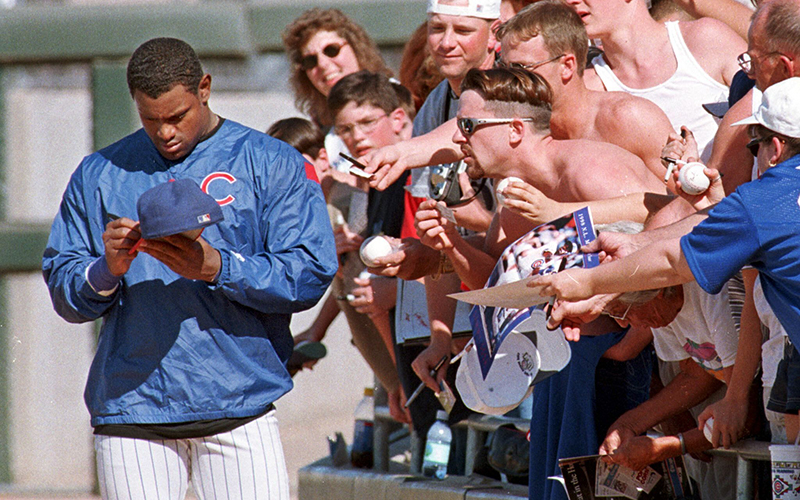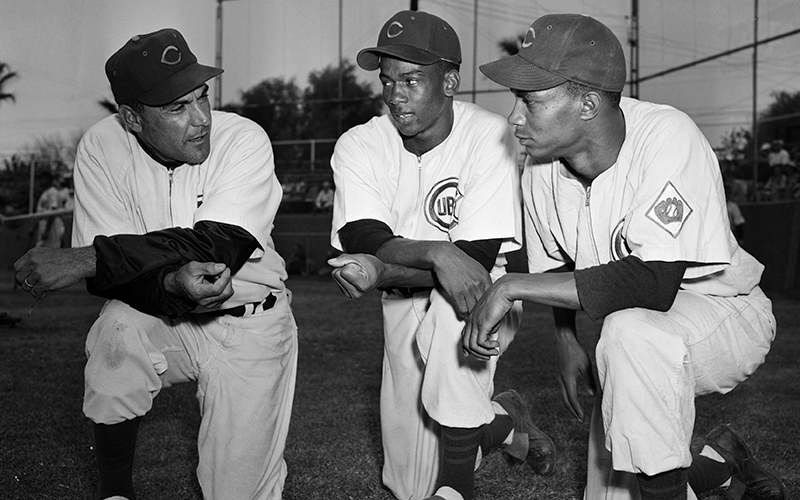PHOENIX – It is hard to imagine, but a time existed when a Major League Baseball player’s rite of passage wasn’t part of the sports narrative in Arizona.
Spring training.
Now it is woven into the fabric of the state. Teams from around the country make the trip as they embark on their goal of a World Series championship. Hope lives, even when it might be slight. “This could be our year” is the fight song of the season.
It wasn’t always this way. Before the 20th century, players would typically prepare on their own and team activities were rare.
“There were brief excursions prior to 1886,” baseball historian Tim Reid said. “There were trips. They were more like barnstorming trips in 1870 with the Cincinnati Reds Stockings and the Chicago White Stockings.”
Now, spring training is a popular tourist attraction, particularly in the Valley. The ideal weather, close proximity of ballparks and quality interleague competition make it an enticing destination for baseball fans across the country. And it is a profitable affair. The 2018 Cactus League season, which was a full spring training season, generated $373 million for the state’s Gross Domestic Product and 6,439 annual jobs, according to a study by the L. William Seidman Research Institute at Arizona State University’s W.P. Carey School of Business.
Early years
Cap Anson is often credited with inventing spring training. A player-manager for the Chicago White Stockings, Anson had the idea of taking his club to Hot Springs, Arkansas, in the mid-1880s. He felt the warmer weather was better for training before starting the season at the team’s cold weather facilities.
He brought a newspaper reporter to publicize the trip, which may be why he is credited with “inventing” spring training, although some have noted that teams were making similar trips 15 years earlier. Hot Springs was a popular place for many reasons, but one obstacle stood in the way of it becoming a massive tourist attraction.
“Hot Springs was known around the world, with affluent people and royalty, but it was very hard to get to,” Reid said. “People had to travel by stagecoaches, even before trains.”
Larry Foley, professor and chair of the journalism department at the University of Arkansas and the director of the documentary “The First Boys of Spring,” said the White Stockings’ trip had an impact on other clubs.
“Now what happened with that particular team?” he said. “Well, they ended up winning the pennant and so you know other teams began to catch on and at that time Hot Springs was a pretty noted spa.”
Having that noted spa made it a popular destination for people who were physically unwell and wanted to heal. “They would go there, because of the thermal waters,” Reid said.
In the book “Under the March Sun,” author Charles Fountain described an environment that emphasized conditioning, not improving baseball skills.
“The ballplayers really would drink a lot in the offseason or otherwise just fall out of shape during the winter,” Reid said. “So their idea was to go down there and lose weight.”
The Hardball Times reported that “much of spring training in those years was given over to long morning hikes of two to seven miles, medicine-ball and Indian-club workouts—an Indian club is something akin to a weighted bat—with maybe some hot baths thrown in to boil out those alcoholic microbes.”

Cap Anson, a player-manager for the Chicago White Stockings, has been credited with inventing spring training and had the idea of taking his club down to Hot Springs, Arkansas, in the mid-1880s because of the warmer weather. Here the White Stockings pose together in Chicago before departure in 1888 for a world tour. (Photo by Mark Rucker/Transcendental Graphics, Getty Images)
Baseball focused
In the mid-1890s, Baltimore Orioles manager Ned Hanlon introduced a more baseball-oriented theme to spring training. For eight hours a day over the course of eight weeks, “Hanlon drilled the Orioles in the hit-and-run, the squeeze play, the double steal, and driving the ball into the ground when the defense was playing deep – the hit that would forever after be known as the ‘Baltimore chop,’” The Hardball Times reported.
The Orioles went on to win three straight American League pennants and their success helped normalize this new style of preseason training.
As with most businesses, success creates imitators and MLB teams certainly took note of Hanlon’s unusual pre-season training methods during their winning years.
After the New York Giants won the 1905 World Series, their manager, John McGraw, saw spring training as a promotional opportunity to perhaps boost ticket sales. The next spring training, players stayed at an upscale hotel in Memphis and were driven to and from every practice with “World Champions” promoted everywhere.
McGraw predicted that the Giants would repeat as world champions, hoping the New York newspapers would print his words. It was his way of gaining an edge over all the other teams.
Hot Springs was an energetic place with numerous entertainment opportunities for players training in the area. Away from the ballpark, players would frequent nightclubs, bars and casinos.
“Hot Springs was like the first Las Vegas,” said Reid, who added, “It was the first gambling center in America. It was a mecca for anything from dice games, card games to horse racing. It was a gambling town but also had incredible health properties.”

In 1952, New York Giants outfielder Willie Mays turned cowboy crooner on the steps of the dugout at the team’s spring training facility in Phoenix. (Photo by Bettmann/Getty Images)
Training during the day would help whip the players’ bodies into shape. Whatever gains they made during the day could be lost in a night spent out on the town with their teammates.
“Take Babe Ruth, for example,” said Reid, who is also an expert on the Great Bambino. “He would lose around seven pounds per day working out, but he’d put on back on at night. (Hot Springs) was that kind of place.”
Around the 1920s, Major League Baseball began to encourage its teams to stop training in Hot Springs, Reid said, because the players were mixing with the big time gamblers who were involved with the 1919 Black Sox scandal.
As soon The Babe left Hot Springs for Florida, interest in Hot Springs cooled off.
“Once Ruth went to Florida for spring training, it was over for Hot Springs,” Reid said. “Teams would make so much more money on the day they played the Yankees with Babe Ruth than they would the entire rest of their schedule playing all the teams.”
Pilgrimage to the West
Following World War I, spring training became a normal occurrence, with teams flocking to warm-weather cities to prepare for the upcoming season.
Before 1959, no MLB team was located west of St. Louis. However, teams still trained on the West Coast. In 1903, the Chicago Cubs practiced in Los Angeles. For nearly two decades, they graced seven different locations before settling on Catalina Island in 1922. The site, just off the coast of Los Angeles, would be their spring home for nearly 30 years.
Dodgers legend Sandy Koufax never trained in Hot Springs, but in the 1960s he was seen frequently heading to the South.
“His arthritic elbow hurt him so much in the latter years of his playing career, he would go to Hot Springs to the arthritis hospital and get treatment,” Foley said.
The Cactus League in Arizona officially began in 1947, although the state’s newspapers mark the date as 1945 when the Cleveland Indians persuaded the New York Giants to join them in the state for spring training.
According to Spring Training Magazine, Giants owner Horace Stoneham received a call from Indians owner Bill Veeck, who praised Tucson as a training site and mentioned that a deactivated war base was available. Stoneham wasn’t too happy with the Giants’ Miami preseason base.
“I told him we’d be interested if another club also would come out so we could have some exhibition games,” the magazine quoted Stoneham as saying.
In 1947, the Brooklyn Dodgers traveled by train and plane to spend 47 days in Havana, Cuba, for spring training. It was the year that Jackie Robinson broke the color barrier.
The white players on the Dodgers stayed at the luxurious Hotel Nacional, which the war veterans and club members from impoverished nations were not accustomed to experiencing. Unlike Hot Springs, there was no gambling or nightclubs to distract the players.
Black players stayed at Hotel Boston in Old Havana, the base for minor-leaguers. This was where many Blacks stayed when they competed in the Cuban Winter League.
The whole idea of going to Cuba was to get off the mainland – but not too far off – and play games against good competition. The Cuban Winter League championship had just finished up. Havana presented a number of attractive qualities, including nice facilities and a close proximity to the United States.

Part of the appeal of spring training is the ability to secure player autographs. In 1999, the Chicago Cubs’ Sammy Sosa signed for fans during the team’s 1999 Cactus League game against the Chicago White Sox in Mesa. (Photo by Mike Fiala/AFP via Getty Images)
Bronx Bombers head to Arizona
In 1951, the New York Yankees were coming off back-to-back World Series championships under manager Casey Stengel. The Yankees had 17 championships and, because of their success, had become synonymous with America. During their title run, they had conducted preseason workouts in Cuba, Bermuda, Venezuela, Panama, New Orleans, Houston, Savannah and often Florida.
Del Webb was the Yankees co-owner at the time. At age 28, he began to suffer from typhoid fever and moved to Phoenix to recover. He invited the Yankees to Arizona for a West Coast tour. In exchange, the Giants joined Florida’s Grapefruit League.
The Yankees’ move to Arizona helped solidify and validate the Cactus League. The Cubs traveled from Catalina Island to play an exhibition series against the Yankees, which led the team to establish a new spring training home in Mesa, where they still train today.
For 11 days, the Yankees barnstormed California. Joe DiMaggio was born in Martinez, California, and played for the San Francisco Seals before the Yankees bought him.
The tour began in Hollywood, where the Yankees played in front of a sellout crowd. The Browns and White Sox also played an exhibition game in front of 235 fans. By the end of the 11-day Golden State swing, the Yankees would play in Los Angeles, Glendale, Sacramento, San Francisco and Oakland. On the trip, Mickey Mantle batted .400 and hit five home runs. In the Yankees’ final game in California against USC, Mantle drove in seven runs.
The California trip may have worked for the Bronx Bombers. They went on to win their third straight title in what would be a string of five consecutive championships.
Take me out to the ballgame
In the modern age, the idea of spring training has not changed, but the fan experience has.
“Players and fans were just completely intermixed and then you go to the playing field which wasn’t much for playing field,” said Gary Thorne, who covered spring training for 35 years as a broadcaster for the New York Mets and Baltimore Orioles. “There was a big embankment in the outfield where a lot of people used to sit on the ground. It had some bleachers around first and third base sides, but it was completely open, there was no stadium.”
Spring training has become a tourist attraction for families, many traveling to Arizona or Florida during their children’s spring break from school.
“You’ve got 5,000, 6,000 fans showing up for games, whereas there used to be a few hundred that showed up for spring training games before,” Thorne said. “It’s become a real moneymaker for the clubs to do this in spring training so it’s been an enormous change from what it was even as recently as the mid-80s.”
Spring training has evolved but remains important to the sport. Over the last few decades, fans have enhanced the experience enhanced by fan interest. The players are the product while the fans are the business. There’s no business without fans.
As long as tickets are bought, hot dogs are eaten and jerseys are worn, spring training will endure and baseball will hold onto its monker of “national pastime.”

